#hitotsume kozou
Photo
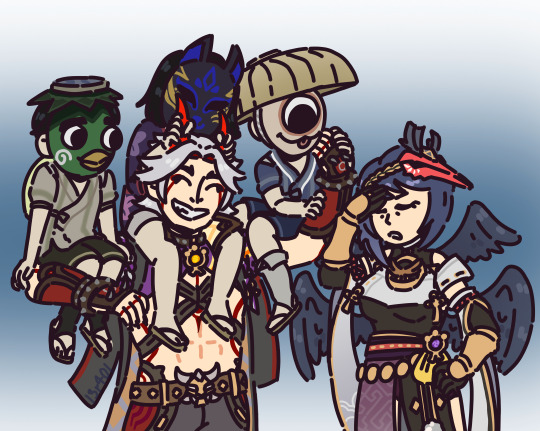
The real crime is that Sara as a yokai didn't attend the yokai event
#Ittosara#arataki itto#kujou sara#kappa#youko#hitotsume kozou#Genshin#genshin impact#genshin impact fanart
309 notes
·
View notes
Text

"Shrine of the Colonies" by Chris Ostrowski.
11 notes
·
View notes
Text
Akitsu Yuugei, Akitsu Kimodameshi
Spoilers for the event!
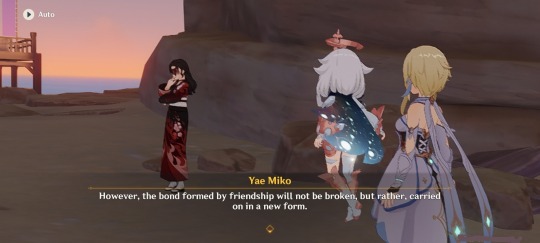

I know by now I shouldn't be surprised by Yae's all-knowing nature but that doesn't stop me from being suspicious of her.
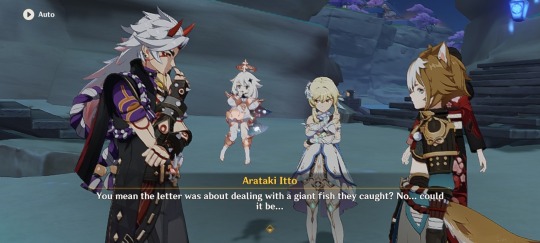
Itto is such a dumbass but I feel like he'll get there eventually...

I MAY OR MAY NOT HAVE CRACKED UP AT THIS.

Same, Chizuru. Same.

😭
#genshin impact#akitsu yuugei#akitsu kimodameshi#chizuru#you will be missed#traveler#yae#yae miko#paimon#itto#arataki itto#gorou#hanyuuda chizuru#hitotsume kozou#i wish that every day of your journey ahead will be filled with joy like a festival#literally hyv making these cool side stories and then making us cry#how could you
17 notes
·
View notes
Photo

6 notes
·
View notes
Note
you've mentioned the hitotsume-sama origin story twice and now im curious
Ok so i think I’ve read the origin story in like two or three occasions? Both are similar tho they have different details so if I get mixed up and get it wrong I apologize
Basically when Eve was an elementary schooler, he would have this dream of a tall skinny figure with one eye that would be standing on his apartment’s hallway seemingly doing nothing. He can’t recall why he got those dreams but at some point they just stopped and left it at that.
Fast forward to a couple of years later when he began writing Nonsense Bungaku, he was watching a horror movie that too had a creature similar to the one of his dreams. He said that seeing that movie with that monster made all the trauma from his childhood come back to him, to the point of giving Mah pics of the movie’s monster as reference to make Hito. Eve said he did it to overcome any trauma he had with said dream and even asked Mah to make him dance “cutely”, which seemed to work bc now he feels attached to Hitotsume and loves him at lot...no wonder he’s his logo now.
So yeh basically Hito came from a nightmare! Tho he never really mentions where the name came from I assume it is from the fact that Hito is a cyclops. “Hitotsume” meaning “one eye”, it’s the name given to the japanese cyclops the “Hitotsume Kozou” a “Hitotsume Nyuudou” (won’t explain this bc it’s gonna be too long and you won’t care for that anyway)
So there you have it!
Ps: to the person who put Hito on the sexypedia I hope you are aware you are sexyfying a man’s childhood trauma lmao
39 notes
·
View notes
Text
Obake Karuta pt 3 S
さ - SA
Crying at Night Stone (Sayo no Nakayama)

し - SHI
Tongue (Shita) of the Hitotsume kozou
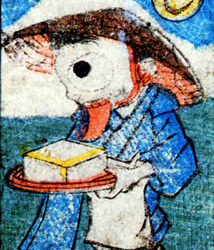
す - SU
Suruga Bay’s Onibi
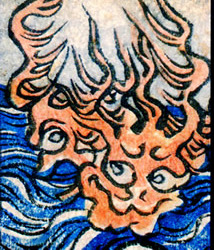
せ - SE
Umibozu on the skipper (senchou)
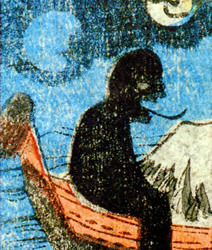
そ - SO
Hitodama flying in the sky (sora)

Obake Karuta posts:
Part 1 Vowels, Part 2 K, Part 3 S, Part 4 T, Part 5 N,
Part 6 H, Part 7 M, Part 8 Y, Part 9 R, Part 10 W
2 notes
·
View notes
Photo

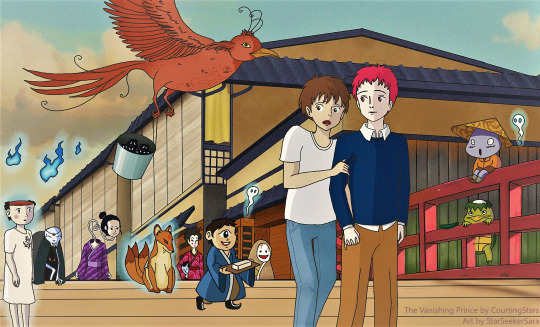
Please enjoy this illustration for Chapter 5 of The Vanishing Prince by the lovely CourtingStars! I knew as soon as I read it that I wanted to draw the scene with monsters and ghosts passing by Akashi and Furi in Kyoto. Because this section of the fic just screamed Ghibli, I knew I wanted it to be the classic Ghibli style (I know, I need more practice lol). The bridge is directly borrowed from Spirited Away and the clouds are from another Ghibli film which I can’t remember T.T The rest is all original and drawn by me, which is why the perspective is so bad /lol. I have been working on this for a long time and at this point I can’t keep looking at it anymore because the more I look the worse it seems so please just enjoy it as it is (,,꒪꒫꒪,,). I’m also including an edited “version 2″ that reminded me a lot of watching old VHS tapes as a kid :)
As always thank you to the author for continuously providing us with this gem of a fic. <3
Youkai/mosters/ghosts from fic:
- Hitodama
- Rokurokubi
- Hitotsume-kozou
Other youkai I added:
- Kiko
- Suzaku
- Kappa (I love them they’re silly)
Youkai I made up:
- Brainless boy spirit
- Creepy evil grandpa
- Killer maiko (may be kitsune, up to you)
- Deadly No Face
- Purple fisher kid
- Coal babies in a bucket
I may add even more youkai to this illustration in the future! I will post it here also if I do. If you like this, consider supporting me <3 THANK YOU!
#kuroko no basket#kuroko no basuke#kurokos basketball#akashi seijuro#akashi seijuuro#kurihata kouki#akafuri#the vanishing prince#courtingstars#boys in love#dorks in love#fanart#ghibli#ghibli style#youkai#yokai#japanese monsters#ghosts#hitodama#rokurokubi#hitotsume-kozou#kiko#suzaku#kappa#my art#krita#favorite fanfiction
7 notes
·
View notes
Text
Notes for The Vanishing Prince, Chapter Five
All right, here we go! Chapter Five has a bunch of stuff that I’ve been looking forward to include in the series for a loooong time. There were also a few surprises that popped up when I wrote it, particularly the revelation about this moment in KnB canon:

So yeah, if you were ever wondering how or why Bokushi came up with that idea, well… I guess I made up a theory about that? //nervous laughter Fair warning, it’s probably about as disturbing as you’d expect. And on that note…
Content Warning: A brief mention of the history of Japanese ritual suicide.
Cut for rambling about Japanese monsters and ghosts, the Akashi estate in Kyoto, the Akashi family crest, and various notes related to the Akashi family’s history…
Youkai and Japanese Ghosts
I like to think that the night scene in Gion is pretty much the moment when this series transforms into a Miyazaki movie. XD There are so many interesting monsters and ghosts in Japanese legends, you could spend a lifetime learning about them! But I figured I’d give a super-quick overview of the supernatural creatures that were featured in this scene. (Also, I definitely recommend yokai.com if you would like to learn about supernatural creatures from Japanese folklore. It’s an amazing resource with a lot of great illustrations!)
Youkai are basically mythical Japanese monsters. There are also yuurei, “vengeful ghosts” who used to be humans. These spirits can exhibit different characteristics and behaviors, depending on the legend. Youkai in particular are generally thought to live in the spirit world, a sort of parallel realm that humans can’t normally see.
The spirit Furihata sees at the shrine is meant to be a kitsune, a fox spirit. (Also my favorite youkai, because they’ve got that whole mythical shape-shifting trickster vibe. //laughs) Kitsune can appear as humans, often beautiful women. Sometimes they even marry humans, and aren’t revealed to be foxes until years later. Or they may lure a human into the spirit world, only for the person to come back and find out that a really long time has passed in the world of the living while they were gone. (There’s also some interesting historical stuff about fox spirits supposedly possessing people, usually young women, but I won’t go into that here!)
The first spirits Furihata sees on the bridge are two types of one-eyed youkai. The hitotsume-nyuudou generally looks like a priest, and can sometimes shape-shift to gigantic proportions. (There are famous stories about them from the Kyoto region, which is one reason I chose to include one in this scene!) Meanwhile, the childlike hitotsume-kozou are weaker, more mischievous youkai. They appear dressed like little boys, and often have long very tongues. Some of them also have a preference for tofu, which seemed appropriate for this fic? //laughs
The blue flames Furihata sees on the bridge are probably hitodama, which are manifestations of dead people’s souls. This is why in Japanese ghost stories, ghosts are often portrayed as having blue flames floating around them. It’s a classic ghost trope, basically, which is why Furihata is so scared when he sees them. (Even though hitodama, unlike other types of “fireball youkai,” are generally pretty harmless!)
I also briefly mentioned a few more youkai, included the famous tanuki. The female spirit in kimono with the long, stretched-out neck is a rokurokubi. Finally, while I left it pretty vague, the spirit crouching in an alleyway is meant to be a “hungry ghost” or gaki. According to Buddhist beliefs, this is the soul of a person who has been condemned to suffer in the afterlife, often by experiencing extreme hunger or thirst. Believers sometimes leave offerings of various kinds for them, to help ease their suffering.
Supposedly, youkai often appear at twilight. I’ve also read stories where they appear on or underneath a bridge, so I thought that would be a cool element to include in the scene. Kyoto is a common setting for a lot of tales about youkai, although every area of Japan has fascinating myths about them.
“That’s Why I Like You So Much”
This was one of those parts where writing in English didn’t translate easily to a story about Japanese characters… I’m not fluent in Japanese (like, at all XD), but even with the little bit I know, it can get tricky to figure out how to show what a Japanese speaker would say/do in a situation, when it’s not quite what a Western English speaker might say/do? (It’s weird how much language can convey cultural standards, to the point that when you translate it directly, it doesn’t always make sense.)
So Furihata’s line when he’s half asleep would probably be something along the lines of “Dakara suki da”or “Dakara daisuki da.” (I’m leaving the exact line open to interpretation, because reasons? //laughs) In Japanese, when you’re interested in someone romantically, you generally say “I like you” or “Suki da.” (“Suki desu” is the more formal version, or you can also say “Suki da yo” to add emphasis.) So it has strong cultural associations with love confessions and crushes. “I really like you” or “Daisuki da” is a more intense version, closer to “I love you.” Some of the nuances of this are explained in this blog.
Either way, you’re still technically saying that you “like” someone. In fact, it’s the same way you’d say you like your favorite food, or you’re a fan of a certain hobby. Which is why the phrase could be kind of ambiguous, in theory… But attaching it to a person has definite connotations, which is why in the chapter, Akashi goes on to think this:
“He must have misheard, he told himself. The wording was somewhat odd, and out of place. Still, whatever Furihata had said, the emotion behind it seemed clear enough. It was the same simple, honest affection, that Akashi had come to recognize and treasure.”
(Oh, Oreshi. Your denial is so deep at this point? //laughs)
Anyway, this note is really just to point out that a lot of the time, I have no idea what I’m doing when I try to translate cultural norms between Japanese and English. XD; (Especially because I’m a clueless American with zero secondary language skills? //laughs) But it is something that occasionally factors into how I write a scene. I try to make sure that everything still makes sense for English speakers, but it can get kind of tricky when certain cultural things come up, and Akashi’s thought process here was one of those instances.
(On the other hand, it was a little easier to portray why Akashi and Furihata holding hands in public was an odd/uncomfortable experience for both of them… Even though in theory, the cultural reasons for it are a bit different/more complex in Japan compared to Western countries. But there was enough overlap there that I figured it still made sense?)
The Akashi Estate in Kyoto
It was so much fun to finally get to write about the Kyoto estate! It’s been a setting in this series before—mostly in The Fast Train to Kyoto—but those scenes were from Akashi’s perspective. Since it’s so familiar to him, he didn’t really go into detail about what the mansion looks like. I have a lot of headcanons about how the family estate developed… In my head, they used to live in more traditional-style buildings, but various heads of the family decided to update the estate over the years. The current building is a grand Western-style mansion, built by one of Akashi’s great grandfathers. I saved some photos to Pinterest for a general idea of what it looks like, including this and this.
I really wanted it to be a super fancy, over-the-top kind of place—and also visually different from the Akashi home in Tokyo. So it’s bigger and brighter, and the exterior is made of pale stone. Meanwhile, the Tokyo home is smaller and darker and the outside is made of red brick. Plus, the Kyoto residence includes a lot more land around it… Which will be covered in a future chapter!
I also enjoyed deciding what Akashi’s rooms would look like, compared to his rooms in Tokyo. Though to be honest, I see them as pretty similar, just bigger? //laughs The main difference is that instead of a canopy, his bed in Kyoto has a big fancy headboard with curtains built into the wall over it. (I got this idea while hunting for pictures of fancy beds online, no surprise there. XD) For an idea of what it looks like, this is pretty close to what I pictured in my head, but I also really liked this bed, and this is one of the most extra things I’ve ever seen. //laughs I also thought this room was awesome with the darker palette. I have a ton of photos like that on that Pinterest board, which brings me to…
This is probably as good a time as any to mention that I made a Pinterest board for The Vanishing Prince! It has LOTS of cool photos for pretty much every scene in the fic so far (and no spoilers, yay!), including ideas of what the interior of Akashi’s mansion might look like and some seriously GORGEOUS photos of the Gion district in Kyoto at night. There’s also some youkai illustrations and examples of samurai armor and kamon crests. Speaking of which…
The Akashi Kamon (or Family Crest)
Basically, a kamon is similar to the idea of heraldry/family crests in Western countries, in that a lot of Japanese families have one. This is especially true for powerful or “aristocratic” families that can trace their lineage back over many generations, so naturally, the Akashi family needed one! And let me tell you, I went on a JOURNEY to decide what theirs might look like? //laughs I researched a lot of different kamon designs, and while I had already decided it would include a chrysanthemum (the traditional crest of the Emperor and Imperial family, but sometimes incorporated into other family crests in different ways), I didn’t know what else should be in it. I toyed around with some different traditional motifs, like a peony or myouga ginger, but then I got a better idea…
Some of you may remember that a few years ago, there was a line of official Kuroko no Basuke merchandise that included traditional Japanese handicrafts and fabrics. What I liked most about it was the fabric they chose for each of the characters, because they all had some cool symbolism that matched the characters really well. I vaguely remembered that somebody posted about it here on Tumblr (here’s that post, which I dug up after the fact!), but I couldn’t remember what Akashi’s fabric meant. It’s a bit more intricate than everybody else’s because of course it is:

Even though I couldn’t remember what the pattern was, I figured it could be good to include in his family crest in some way? (Since flowers are often included in kamon.) So after some hunting, I figured out that his design includes bamboo and a phoenix flying over a Paulownia tree. The post I linked includes some more details about how these symbols are connected to the Emperor. Also, in Eastern mythology, phoenixes are believed to live in Paulownia trees. They’re believed to bring good fortune to rulers, which is probably why the Paulownia tree is so associated with royalty. Not surprisingly, the tree is also used frequently in Japanese crests—to the point that it’s even used in kamon for the Japanese government. Naturally, I thought the impressiveness of it would be a good fit for the Akashi family as well!
I drew a doodle of what the Akashi kamon in the fic looks like, something like this:
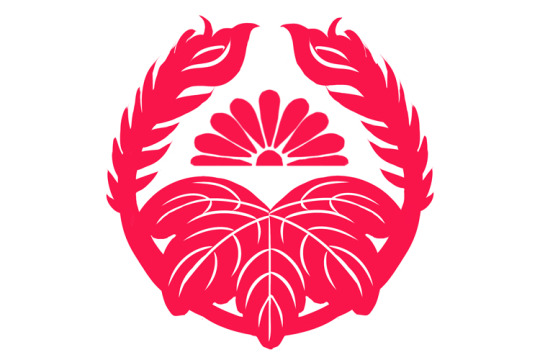
I’ll probably redraw it if I ever use it in actual fan art, but it gets the idea across! The kamon that I added to the Pinterest board includes some examples of how Paulownia trees and phoenixes have been included in other historical crests.
In any case, that’s how the Akashi kamon in this series ended up having a bunch of epic symbols in it! Which seemed appropriate, given the family it represents. XD (There’s also some hidden/secret significance in the design, specifically the part that appears to be two phoenix feathers… But I’ll probably end up going into that later!)
Akashi’s Family History
And now for the big revelation of the chapter… I’ve been wanting to explore the history of the Akashi family for a while, since it’s tied to some of the major themes of this series. The story Bokushi tells in this chapter is definitely meant to be more of a “family legend” than anything historical. But I did do some research on Japanese history, warfare, and legends to try to come up with a story that would fit culturally, while still having a “mythical” kind of feel to it.
I’ve mentioned before that my version of the Akashi family is meant to be a zaibatsu, which is basically a super powerful business family. Their influence tends to get exaggerated in fictional settings like Kuroko no Basuke—in reality, the zaibatsu don’t exist to that degree anymore—and my fic does this as well. It also adds a bit of a twist: before becoming successful in trade and finance, the Akashi family began as a clan of feudal lords.
Feudal Japan was partially governed by local lords called daimyos—who could be descended from the nobility, but weren’t always—and these lords ended up having a lot of power during certain time periods. This could be especially true if they were skilled in warfare and/or employed a lot of samurai. So in the story Bokushi tells, the Akashis were essentially a daimyo family who tried to become even more powerful, and then failed in a really tragic way.
I think most people know the basics about samurai armor, katana swords, and so on, so I won’t really go into those topics…. I did include several examples of samurai armor and weapons over on the Pinterest board I made, so you can get an idea of what the display room in this chapter looks like. (Or you can always google “samurai armor,” that works too! XD) Visors on samurai helmets were sometimes stylized like youkai monsters, to make them appear more intimidating on the battlefield. The Akashi family story also involves an allusion to ritual or “honor” suicide, though the circumstances are different from most samurai stories. (It was meant to show that the Akashi clan’s idea of shame in defeat was much more severe than most.) Since it was such a brief part of the chapter, I won’t discuss the history of ritual suicide in Japan, but it’s easily researchable online. (And as I’m sure most people know, the process is very graphic/disturbing, so please be aware of that.)
As for what inspired the Akashi story, I’m tempted to go on a long tangent here about how Kuroko no Basuke’s overall plot structure takes a lot of cues from samurai tales and Japanese action movies, to the point that this is an ACTUAL MOMENT from the show that I totally forgot about:


(Seriously, a million points to anyone who remembers which two characters were facing off during this moment??? Because I would have gotten one of them wrong for sure. Which actually ties into my point about the structure pretty well. XD)
Anyway, point being, I was definitely inspired by the nods to the Japanese warrior mythos in KnB to include more direct allusions in Akashi’s backstory—and to play around with how that history might have affected his family’s perspective on honor, victory, and defeat.
(I’d also like to note that the way Bokushi says the infamous line about his eyes in KnB canon has a key difference from the way Lord Akashi uses it in the legend… While it’s still emotional manipulation being used as motivation, Bokushi also uses it as a way to say that he’ll take all the blame for a defeat on himself, after intentionally making a shot for the other team. In other words, Bokushi is only holding himself to the Akashi standard. He wouldn’t blame his team for having to give up his eyes the way Lord Akashi blamed his son, because he doesn’t see them as bearing the same level of responsibility—even though he IS extending them the same level of trust, and complete confidence in their abilities. From Bokushi’s point of view, this is all totally obvious—even though it wouldn’t be to everyone else. To me, the distinction is pretty important to my interpretation of his character. But your mileage may vary, of course!)
And A Quick Note on Bokushi’s Theory
Finally, since this story has been exploring Akashi’s mental health, I just wanted to mention something about this line:
“In many ways, the tale had defined him all his life. It had taught him what it truly took to succeed. It was largely inseparable, from his sense of self. Perhaps in a certain sense, it had even caused it.”
Since I’m trying to be as careful as I can with how I portray dissociation, I want to clarify that this isn’t meant to be an explanation for how Akashi developed Dissociation Identity Disorder. Instead, this line is Bokushi’s theory about how/why he developed his personality traits, in comparison to his other self. It’s definitely an oversimplification, since there are many reasons why he behaves the way he does, the same as it is for anyone… But I think it makes sense for Bokushi to point to this family legend, which was told to Akashi at a very formative point in his childhood, as a way to explain his general worldview and priorities.
The question of why Akashi developed more than one self state is more complicated, and will be explored throughout the fic, rather than having one simple, straightforward explanation like this.
Well, that’s it for my notes! To anyone who read all the way through them, I’m very impressed. XD I really was excited to post this chapter—and I hope it was interesting and enjoyable to read in spite of (or because of?) how intense it was. Thank you as always for reading, and I hope to post the next chapter as soon as I can. <3 (It’s already drafted and once again, I’m SO EXCITED. I have a feeling I’ll be saying that a lot for this fic? //laughs)
#the vanishing prince#kat writes fanfic#kat writes about basketball dorks#long post#text post#really long post#good lord how long is this post#hopefully it's interesting though!#and it has lots of pretty stuff especially the pinterest board#which I had way too much fun putting together#okay I'm gonna maybe stop rambling on and on now XD#cw: suicide
25 notes
·
View notes
Photo

Inktober día 26: Hitotsume Kozou
「 一つ目小僧 」
Significa "Monje de un Ojo" y es un youkai inofensivo y travieso semejante a un niño de unos diez años de edad, con un ojo enorme y único, una lengua larga y roja y con la apariencia de un monje budista.
Son bien conocidos en todas las partes de Japón a lo largo de los años. Suele verse en calles oscuras y disfruta de sorprender repentinamente a las personas o bien diciéndole a la gente ruidosa que estén en silencio. Ocasionalmente utilizan su lengua para lamer a la gente.
A pesar de que es inofensivo y travieso, mucha gente considera que un encuentro con un Hitotsume Kozou significa un mal presagio y por esa razón se suele dejar, como tradición, una cesta de bambú en el frente de la casa, ya que ésta los ahuyenta.
Se le representa llevando un Toufu ya que es su comida favorita.
#一つ目小僧#hitotsume kozo#inktober#inktober 2018#31yokais#anime#manga#hitotsume#one eye#one eye monster#monster#demon#cute#kawaii#kid#kimono#japan#japanese#terror#horror#tofu#ink#watercolor#draw#drawing#illustration#argentina
3 notes
·
View notes
Text
Onmyouji Maintenance
2017/4/21 08:00-10:00
Update Contents
1. BFF System
A) When bond points with a friend reaches a certain number, BFF function is unlocked. Bond points can be earned by teaming up, sending shards, pressing ‘Like’, co-operative missions, demon parade invitations.
B) BFFs have the BFF Shikigami Co-op Function unlocked. BFFs will give a multiplayer bonus, 2x friendship points, login notifications as a bonus. Furthermore, you can borrow your BFF’s shikigami for story, exploration, mitama, awakening, and skin dungeons (except for floor 10), and youki seals. You can receive a variety of rewards for borrowing shikigami.
C) Bond points can be confirmed by pressing the arrow button on the Friends screen, then the ‘Bond (絆)’ button.
D) Details about the BFF system can be confirmed by pressing the ‘?’ mark on the Friends screen, or the ‘!’ mark on the Co-op Battles (協戦) screen
2. Photo Exhibition Function
A photo exhibition function has been added in addition to the shikigami display and bulletin board on your personal home page. Photos can be ‘Liked’.
3. Exchange Shop Update
New shikigami ‘Mannendake (万年竹)’ (3500 tickets) x3 and 4* White Daruma (200 tickets) x2 added. Exchangeable until 2017/4/26 23:59.
4. Amulet Event
Event period: until 2017/5/4
Daily Awakening/Mitama dungeon drop boost amulet and Experience/Coin boost can be collected from the paper doll in the courtyard. Amulets last for 1.5 hours, boost lasts for 1 hr.
Skill Adjustments
Skill cooldowns now carry between stages of an instance. For example, mitama dungeons have 3 stages.
Onmyouji: Abe no Seimei
‘Shield (言霊•守)’: Barrier fades after 2 turns.
Onmyouji: Kagura
‘Longevity (延命)’: No longer affects summons.
‘Sacred Fox (天狐神火)’: Counter condition changed from ‘receive damage’ to ‘receive attack’.
SSR: Aragawa no Arugi
‘Ravenous Appetite (貪食)’: Aragawa no Aruji uses demon power to change water into the shape of a fish and send it at an enemy. Deals 132% of attack power. Removes 2 buffs from the enemy. Deals an extra 132% damage with a second attack. Each removed buff causes the second attack to have 5% increased damage. Mitama that activates on the first hit is carried through to the extra damage on the second hit.
SSR: Shishio
'Wrath of Revenge (復讐の怒り)’: Shishio strengthens each time an enemy or ally is defeated. Absorbs 40% of the enemy’s attack power, transforming it into his own. Can be done up to 3 times and doesn’t pass 200% of Shishio’s own attack power.
‘Deer Antler Collision (鹿角衝突)’: Shishio pours all his demon power into his antlers and charges into a single enemy. Deals 145% of attack damage. For each ‘Wrath of Revenge’ another enemy is targeted.
SR: Kairaishi
‘Puppet - Followup Attack (傀儡•追撃)’: When Kairaishi deals damage, 20% chance of dealing damage equal to 10% of the enemy’s max HP. Damage cannot exceed 80% of own attack power.
SR: Futakuchi Onna
‘Fear (恐怖)’: Gains 4 bullet seals at the start of the battle. Every time an ally moves after that gives 40% chance of gaining another seal. Up to 6 seals can be stacked.
‘Apology (謝罪)’: Increased bullet damage.
SR: Jorougumo
‘心噛み髄食い’: Summons a spider web to attack all enemies, dealing 106% of attack damage. Enemies with less speed than Jorougumo have a 20% (+effect accuracy) chance of being stunned. Enemies with a higher speed than Jorougumo receive 25% more damage. The greater the speed gap the higher the chance of stun and damage received.
SR: Aobouzu
‘Zen Mind (禅心)’: Attacks all enemies, dealing 106% of attack damage. Wipes all buffs and damages summons for 30% of their max HP. This damage cannot be more than 30% of Aobouzu’s max HP. Further doubles the effect of ‘無量光' for 1 turn.
SR: Mou Baa
‘Gifts from the Heavens (空からの落し物)’: Attacks a single enemy, dealing 211% of attack damage. Has a 90% (+effect accuracy) chance of silencing for 2 turns. Damages other enemies for 27% of attack power, with a 25% (+effect accuracy) chance of silencing for 1 turn.
SR: Hone Onna
‘One Step One Breath (一歩一息)’: Skill damage has been increased.
R: Sanbi no Kitsune
‘Temptation (誘惑)’: Fixed explanation mistake.
R: Koi no Sei
‘Bubble Prison (泡の牢獄)’: Now affects Onmyouji. Cooldown of 1 turn.
R: Gaki
Skills have been redone.
‘Rotten Manju (腐った饅頭)’: Throws a rotten manju at an enemy, dealing 100% of attack damage. Erases 1 buff. Further 30% (+effect accuracy) chance of carving 1 manju seal.
‘Thievery (窃盗)’: Passive. When allies use a normal attack, Gaki has a 10% chance of helping out with ‘Rotten Manju’, attacking the enemy too.
‘Drink Like a Fish, Eat Like a Horse (鯨飲馬食)’: Gaki eats an enemy, dealing 100% of attack damage with a 30% chance of swallowing the enemy. Gaki has a 15% chance of spitting out the enemy when attacked. Further erases all buffs from enemy. For every manju seal, the rate of being swallowed increases by 30%. If the enemy isn’t swallowed, 1 seal is carved.
After awakening: When an enemy is defeated through 鯨飲馬食, Gaki fully recovers.
R: Karasu Tengu
‘Wild Bird Flock (群鳥の乱舞)’: Attacks all enemies, dealing 119% of attack damage. For every enemy decreased (敵が1体減少するごとに), damage by the skill increases by 20%. Max of 100% increase.
R: Samurai no Rei
‘Resentment of Lost Souls (亡魂の憤り)’: Attacks all enemies by releasing lost souls, dealing 93% of attack damage. Lost souls exist for 3 turns, possessing an enemy. When the enemy uses onibi, the lost souls cause the enemy to receive 50% of Samurai no Rei’s attack damage times the number of turns the lost soul exists. When lost souls are released by skills, the enemy loses 1 onibi. Up to 3 onibi can be lost in 1 turn.
R: Kyonshii Otouto
‘Toxic Spray (毒気噴水)’: Attacks all enemies, dealing 76% of attack damage. Enemy receives 22% of Kyonshii Otouto’s attack damage for 2 turns. Once the damage runs out, the enemy will become poisoned. Enemy receives 20% more damage.
R: Kyonshii Imouto
‘もうやらないよ'::ターン終了時、キョンシー妹は30%の確率で元の場所にしゃがみこんでないたり、甘えてとぼけたりする。その際、味方全体の防御力が30%アップする。
「ワンちゃん出撃」:敵または味方の式神が倒れた位置にキョンシー犬を召喚する。キョンシー犬のHP、攻撃力はそれぞれキョンシー妹のHP、攻撃力の10%と50%になる。キョンシー犬はHPの一番低い敵を優先的に攻撃する。
R: Hitotsume Kozou
「金剛経」:一つ目小僧はダメージを受けた時、味方全体を加護する為に経文を読誦する。味方の効果抵抗を10%アップさせ、受けたダメージの10%を敵に反射する。一つ目小僧は1ターンの間、読誦状態になる。この効果は解除できない。
R: Tesso
「あぶく銭護身」:バッシプスキル。鉄鼠が攻撃を受けた時、40%(+本来の確率*効果命中)の確率で攻撃者の攻撃力を20%ダウンさせる。
「銭こそ、正義だ」:数え切れないほどの銭貨を妖力で操り、敵全体に2回ぶつけ、息つく暇も与えない。毎回につき目標に攻撃力の44%相当のダメージを与える。さらに50%(+本来の確率*効果命中)の確率で敵の被ダメージを30%アップさせ、2ターン間継続する。この効果は重ねがけができない。
R: Kudagitsune
「爆撃砲」:管狐は妖力を竹管に注ぎ込んで、敵単体に雷雲弾を砲撃する。目標に攻撃力の228%相当のダメージを与える。さらに、40%の確率で目標の鬼火を1点失わせる。会心時、その確率は80%にアップする。
N: Amanojaku Midori/Aka/Ki/Ao
Skill explanation mistakes have been fixed.
Bug Fixes
1. Explanation added for recovery decreasing as turns pass by in Arena.
2. Kamigui’s codex entry voice has been fixed.
3. Level display error for Dorm Kekkai Toppa has been fixed.
4. Bounty Board explanation mistake for Black Panther has been fixed.
5. When spectating shikigami reach max level, they will be automatically swapped out for another shikigami.
6. Minor translation mistakes fixed.
0 notes
Photo

The Classic Youkai Trio!!
#youkai watch#karakasa obake#rokurokubi#hitotsume kozou#body horror///#????#for rokurokubi anyway#my crappy doodles
25 notes
·
View notes